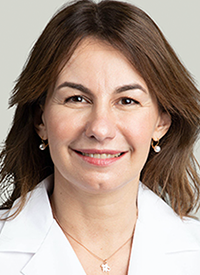Commentary
Article
ODAC Vote Aims to Introduce Clarity on Phase of Treatment Benefits in Resectable NSCLC
John V. Heymach, MD, PhD, and Marina Chiara Garassino, MD, detail new trial design proposals for perioperative regimens in resectable NSCLC.
Marina Chiara Garassino, MD

Amendments to future perioperative clinical trial designs in resectable non–small cell lung cancer (NSCLC) will be worth considering following questions raised at the FDA’s Oncologic Drugs Advisory Committee (ODAC) meeting regarding the contribution of phase of such treatment regimens, according to John V. Heymach, MD, PhD.
“Given that at least 60% of this population [will experience] recurrence and that PD-1 inhibitors are generally well tolerated in the adjuvant setting, that makes this a cost/benefit question,” Heymach said in an interview with OncLive®. “Is the field better off investing resources in figuring out the optimum duration of a drug that’s relatively well tolerated or trying to move forward with new combinations that will increase cure rates?”
The ODAC meeting, which occurred July 25, 2024, concluded with an 11 to 0 vote that the FDA should require adequate within trial assessment of contribution of treatment phase in new trial design proposals for perioperative regimens in resectable NSCLC.1
Joined by Marina Chiara Garassino, MD, professor of medicine and leader of the thoracic program at UChicago Medicine in Illinois, Heymach unpacked implications of discussions from the ODAC meeting. Heymach is chair; professor; and the David Bruton, Jr Chair in Cancer Research in the Department of Thoracic/Head and Neck Medical Oncology at The University of Texas MD Anderson Cancer Center in Houston. He is also a professor in the Department of Cancer Biology.
Heymach and Garassino also highlighted key takeaways from the ODAC meeting and data from the phase 3 AEGEAN trial (NCT03800134), which was discussed at the meeting, in a concurrent interview.
OncLive: What does this decision indicate about the future of drug development in oncology and do you believe that such a decision could potentially hinder drug development?
Heymach: It’s an important question, and on one hand, we would always like to know the relative contribution of everything we give [to patients]. But the reality is we don’t typically have that information and the time it would take to learn often would be too long and the benefits would not be large enough to make that the focus of the studies.
For example, in the metastatic setting, we’re not sure how long we should give maintenance therapy for—is it 6 months, 1 year, or 2 years? But it would take so long to do those studies, [thus] it’s felt to not be the top priority.
Adjuvant and neoadjuvant and perioperative studies take a very long time to read out [as well, and] a typical time frame might be 5 to 8 years to get a readout. If we do studies focused on the contribution of phase with therapies that are well tolerated, the plus is that we have greater certainty whether we need both the neoadjuvant and the adjuvant [therapies]. The downside is it means during those 7 or 8 years, we weren’t investigating newer regimens that might improve cure rates.
Garassino: I agree. It’s not just a matter of new trials with new drugs. We should also work to understand who the patients are who really need to receive the adjuvant component [of therapy]. Taking advantage of liquid biopsy, radiomics, the patient’s conditions, and many other things [is important so] it’s possible that in the future we [can] personalize the adjuvant component more.
I have been in Italy for most of my life, [and] I believe that it will be very difficult for European countries—for socialized countries like Canada where there are full reimbursements—to accept continuously adding clinical trials. These kinds of trials will help a lot, particularly [for] those countries where it is possible [they won’t have access to perioperative regimens].
What are your thoughts on some of the suggestions that the FDA posed for future trial designs in the perioperative setting?
Heymach: The FDA raised concerns that they were going to make [the process of] trials much slower, which may not be beneficial, and they raised the possibility of novel designs or using other markers potentially as end points which is a wonderful suggestion. If we’re mandating that studies require understanding the contribution of phase [of treatment], but we’re potentially accelerating research using biomarkers such as pathological complete response [pCR], then it may not delay development so much; it may give us more information.
I hope, and we are eager to pursue, trials that can more quickly lead to development of new, more effective regimens using biomarkers. Perhaps an accelerated approval based on a biomarker, such as pCR, but then longer follow-up for more accepted end points such as event-free survival or overall survival down the road [would be optimal].
It’s important that we don’t hinder drug development by making even simple studies suddenly take 10 years and be 3 times as large, because although we may gain a little bit of information about contribution of phase [of treatment], it may make each study impossible and slow the rate of novel development. This is a problem when over half of patients [experience disease] recurrence. We welcome novel trial designs that incorporate biomarkers as surrogate end points and will eagerly pursue those possibilities with the FDA and others.
Garassino: I agree.
Was there anything that came up during the ODAC discussion that surprised you?
Garassino: The committee was worried about toxicity, [but] I don’t believe that toxicity is an issue for the adjuvant component [of therapy]. Thousands of patients have been randomly assigned [in trials to receive perioperative regimens], and we know that toxicity—which is present in approximately 9% to 10% of patients [included in these trials]—is mainly represented by hypothyroidism. [Hypothyroidism] is clearly a toxicity because patients have to take a pill forever [as a result and] that is not a toxicity for which we can repair the quality of life of the patient.
Heymach: Given the favorable tolerability profile of immunotherapy and that more than half of the patients in these studies [will experience disease] recurrence, I’m surprised about the relative weighing of the toxicity compared with the possible benefits of finding newer, more effective regimens that would increase cure rates. If our cure rates were already very high, then I would understand that focus a bit more.
For example, in the setting of adjuvant breast cancer studies cure rates are already extremely high, and that’s been a result of decades of studies and incremental improvements. We’re behind that in lung cancer, so this is something the field must devote themselves to [in terms of] how we can increase cure rates as quickly as possible, but also make it feasible for patients to receive effective therapies and limit toxicities as well as costs. The FDA doesn’t explicitly weigh in on costs, but it’s something the field has to take into account too.
What were your thoughts on some of the opinions that were raised during the open hearing?
Heymach: In the open hearing there was a diversity of opinions presented as happens in open committee. This reflected in part that the committee makeup is diverse and includes some doctors with lung cancer expertise, surgical expertise, and expertise in other diseases, as well as patient advocates, and during the open questioning any member of the public. A benefit of such an open hearing is getting that diversity of opinions and I believe that certainly happened.
Garassino: We were [also] surprised that the vote was for the future [of trials] and not for [data from] the phase 3 AEGEAN study.
Heymach: [Yes, this was] because we initially thought the first question was going to be a voting question but was a discussion question—the results were not announced of the discussion. But it’s important that the points raised by the committee be conveyed that there was agreement that additional studies are not needed [for perioperative durvalumab] and that the AEGEAN study was positive in terms of achieving its end point. It was gratifying to investigators involved for that to be recognized.
Garassino: I agree with the FDA that more research is needed. As a researcher, our concern is that the timelines of the research will be [very long]. I will be retired [before seeing] the next generation of adjuvant treatments.
Reference
- Oncologic Drugs Advisory Committee (ODAC) Meeting. Combined FDA and applicant ODAC briefing document. Accessed August 19, 2024. https://www.fda.gov/media/180242/download








